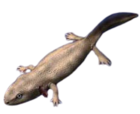Ichthyophiidae
| Ichthyophiidae | |
|---|---|

| |
| Ichthyophis sp. from the Western Ghats | |
| Scientific classification | |
| Domain: | Eukaryota |
| Kingdom: | Animalia |
| Phylum: | Chordata |
| Class: | Amphibia |
| Order: | Gymnophiona |
| Clade: | Apoda |
| Family: | Ichthyophiidae Taylor, 1968 |
| Genera | |

The Ichthyophiidae are the family of Asiatic tailed caecilians or fish caecilians found in South and Southeast Asia as well as southernmost China.[1]
They are primitive caecilians, lacking many of the derived characters found in the other families. For example, their mouths are not recessed underneath their heads, they possess tails, and they have numerous scales on their bodies. However, they have two sets of muscles for closing the jaw, a feature unique to caecilians, but absent in the related family Rhinatrematidae.[2]
They lay their eggs in cavities in moist soil, where they hatch into larvae that seek out streams or underground seepages, before metamorphosing into adults. Some evidence indicates the females may protect their eggs until they hatch.[2]
Taxonomy
[edit]Family Ichthyophiidae
- Genus Ichthyophis
- Ichthyophis acuminatus
- Ichthyophis alfredi
- Ichthyophis asplenius
- Ichthyophis atricollaris
- Ichthyophis bannanicus
- Ichthyophis beddomei
- Ichthyophis bernisi
- Ichthyophis biangularis
- Ichthyophis billitonensis
- Ichthyophis bombayensis
- Ichthyophis cardamomensis
- Ichthyophis catlocensis
- Ichthyophis chaloensis
- Ichthyophis daribokensis
- Ichthyophis davidi
- Ichthyophis dulitensis
- Ichthyophis elongatus
- Ichthyophis garoensis
- Ichthyophis glandulosus
- Ichthyophis glutinosus
- Ichthyophis humphreyi
- Ichthyophis hypocyaneus
- Ichthyophis javanicus
- Ichthyophis khumhzi
- Ichthyophis kodaguensis
- Ichthyophis kohtaoensis
- Ichthyophis lakimi
- Ichthyophis laosensis
- Ichthyophis larutensis
- Ichthyophis longicephalus
- Ichthyophis mindanaoensis
- Ichthyophis monochrous
- Ichthyophis moustakius
- Ichthyophis multicolor
- Ichthyophis nguyenorum
- Ichthyophis nigroflavus
- Ichthyophis nokrekensis
- Ichthyophis orthoplicatus
- Ichthyophis paucidentulus
- Ichthyophis paucisulcus
- Ichthyophis pauli
- Ichthyophis pseudangularis
- Ichthyophis sendenyu
- Ichthyophis sikkimensis
- Ichthyophis singaporensis
- Ichthyophis sumatranus
- Ichthyophis supachaii
- Ichthyophis tricolor
- Ichthyophis weberi
- Ichthyophis youngorum
- Genus Uraeotyphlus
References
[edit]- ^ Frost, Darrel R. (2013). "Ichthyophiidae Taylor, 1968". Amphibian Species of the World 5.6, an Online Reference. American Museum of Natural History. Retrieved 23 April 2013.
- ^ a b Nussbaum, Ronald A. (1998). Cogger, H.G.; Zweifel, R.G. (eds.). Encyclopedia of Reptiles and Amphibians. San Diego: Academic Press. p. 55. ISBN 978-0-12-178560-4.
- Nussbaum, Ronald A. and Mark Wilkinson (1989). "On the Classification and Phylogeny of Caecilians." Herpetological Monographs, (3), 1-42
- San Mauro, Diego; David J. Gower; Oommen V. Oommen; Mark Wilkinson; Rafael Zardoya (November 2004). "Phylogeny of caecilian amphibians (Gymnophiona) based on complete mitochondrial genomes and nuclear RAG1". Molecular Phylogenetics and Evolution. 33 (2): 413–427. Bibcode:2004MolPE..33..413S. doi:10.1016/j.ympev.2004.05.014. PMID 15336675.
- San Mauro, Diego; Miguel Vences; Marina Alcobendas; Rafael Zardoya; Axel Meyer (May 2005). "Initial diversification of living amphibians predated the breakup of Pangaea" (PDF). American Naturalist. 165 (5): 590–599. doi:10.1086/429523. JSTOR 10.1086/429523. PMID 15795855.
- San Mauro, Diego; David J. Gower; Tim Massingham; Mark Wilkinson; Rafael Zardoya; James A. Cotton (August 2009). "Experimental design in caecilian systematics: phylogenetic information of mitochondrial genomes and nuclear rag1". Systematic Biology. 58 (4): 425–438. CiteSeerX 10.1.1.577.2856. doi:10.1093/sysbio/syp043. PMID 20525595.
- Frost, Darrel R. (2019). "Ichthyophiidae". Amphibian Species of the World: an Online Reference. Version 6.0. American Museum of Natural History, New York, USA. Retrieved 7 October 2019.
- AmphibiaWeb: Information on amphibian biology and conservation. [web application]. 2004. Berkeley, California: AmphibiaWeb. Available: http://amphibiaweb.org/. Retrieved 26 August 2004




